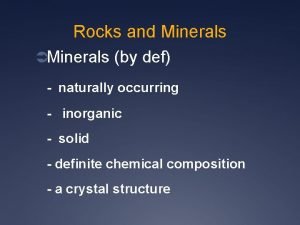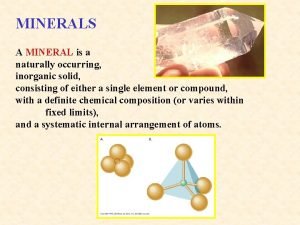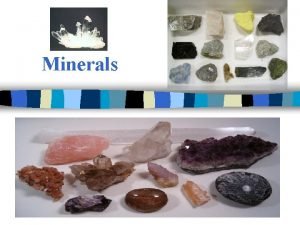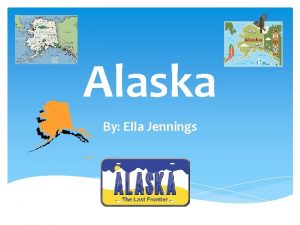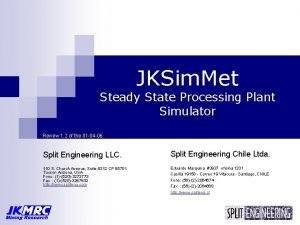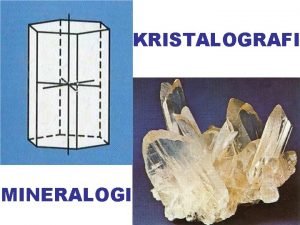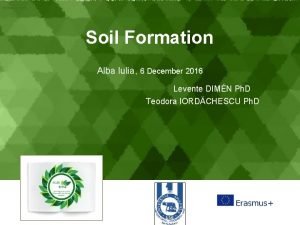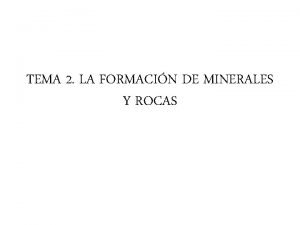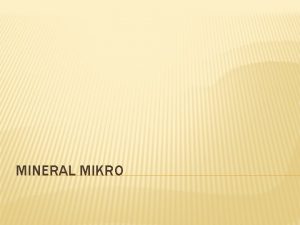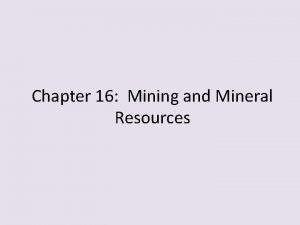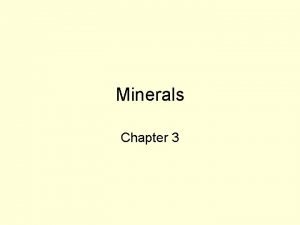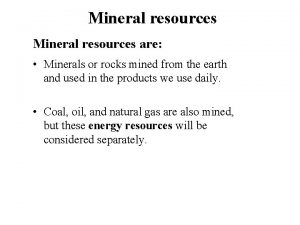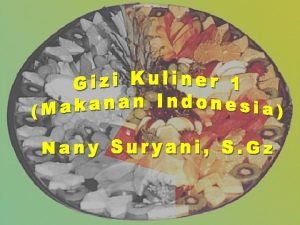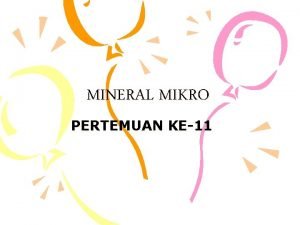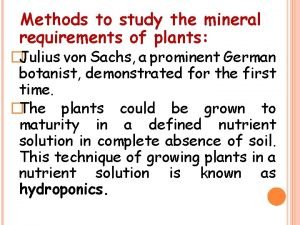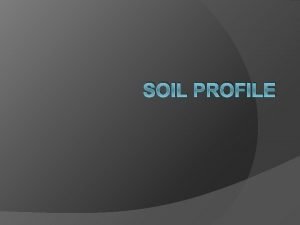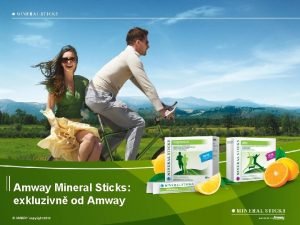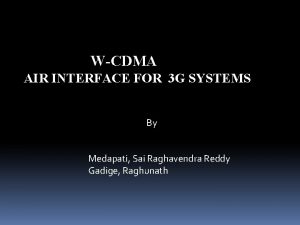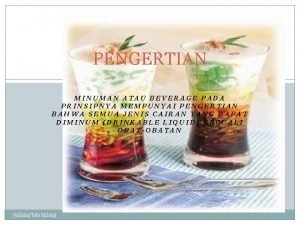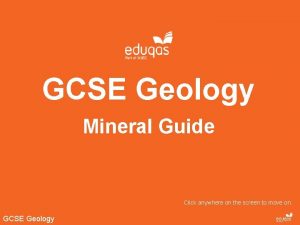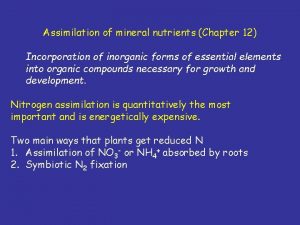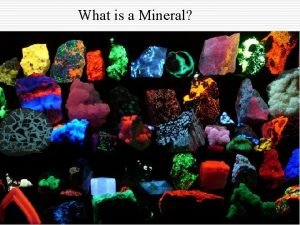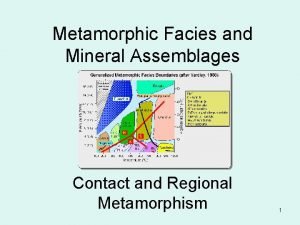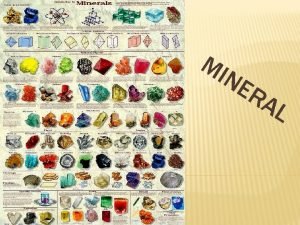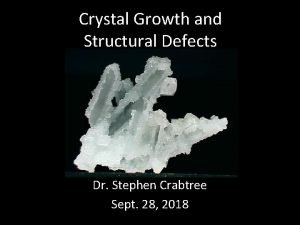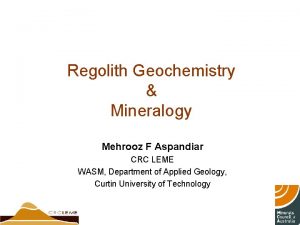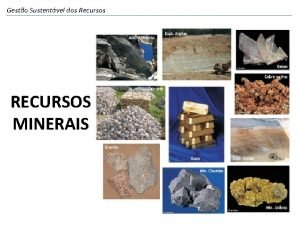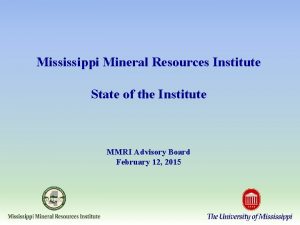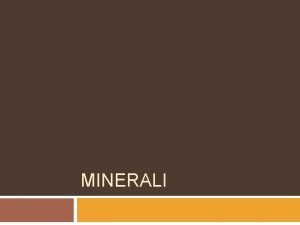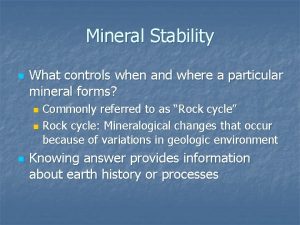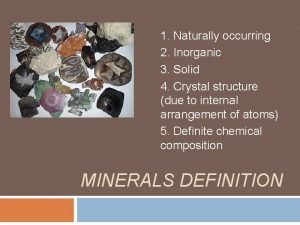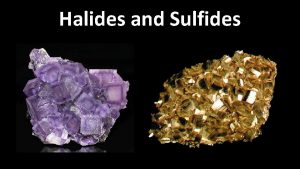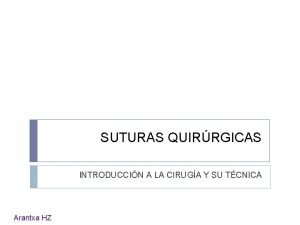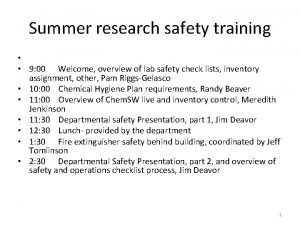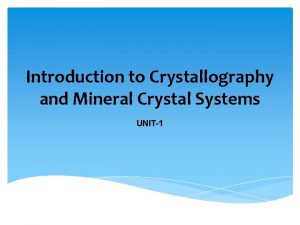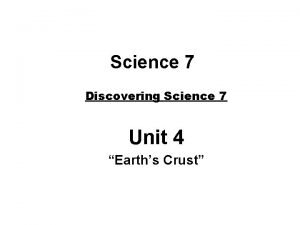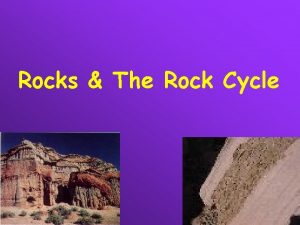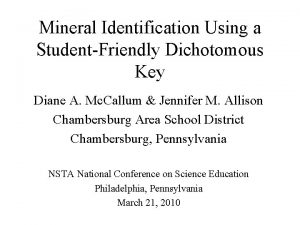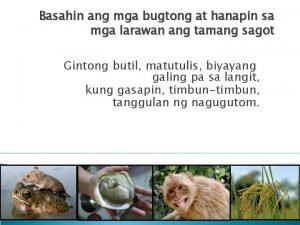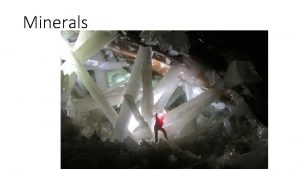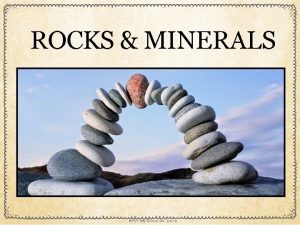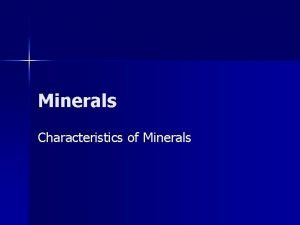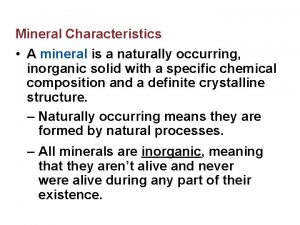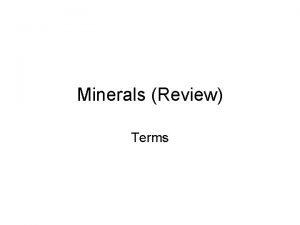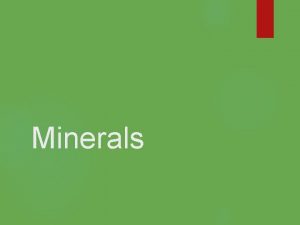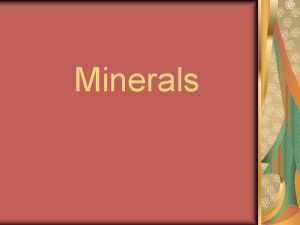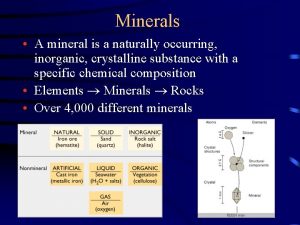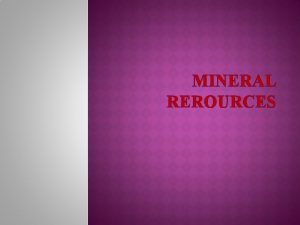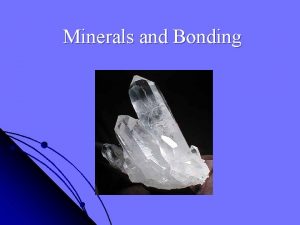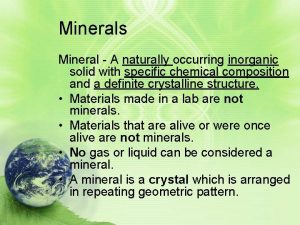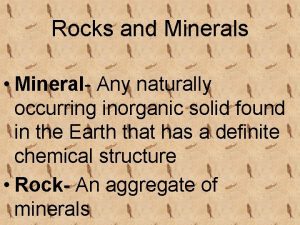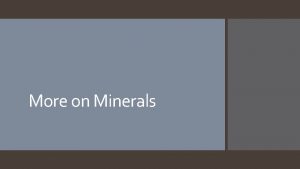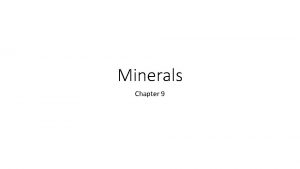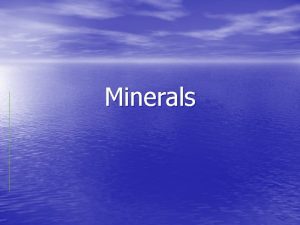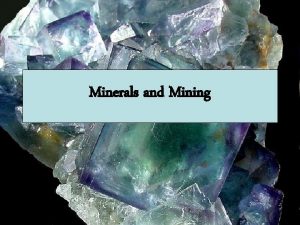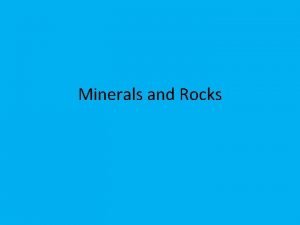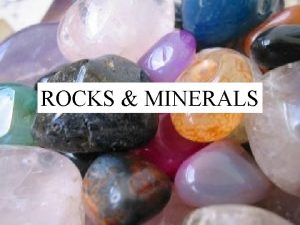Minerals What is a mineral 1 Occur naturally















































- Slides: 47

Minerals What is a mineral? 1. Occur naturally 2. Solid 3. Inorganic 4. Definite chemical composition 5. Internal arrangement of atoms is in an orderly pattern

How to ID Minerals Physical properties of a mineral: determined by the internal arrangement of atoms 1. Color a. 1 st recognizable pattern examples: sulfur, malachite b. least useful – more than one mineral may have the same color.

Mineral Color Continued Same color minerals n Quartz n Halite n Calcite

Mineral Color Continued c. Also least useful because minerals can have more than one color. Such as the minerals: n. Milky quartz, Rose quartz, Clear quartz, Purple fluorite, Green fluorite, Yellow fluorite

Analogy: Minerals are like Fire Trucks Red Truck, BUT not a Fire Truck No hoses, ladders, sirens or flashing lights characteristic of Fire Trucks. Red truck again, BUT not a Fire truck

It’s RED and it’s a Truck, it has ladders, hoses, flashing lights and a nice sign on the door that says “Fire Dept. ” It’s a Fire truck! Still a Fire Truck? Of course, it has ladders, hoses, flashing lights, and a nice sign on the door that says “Fire Dept’”

Still a Fire truck? Despite the fact that the fire men might not want to ride in it? Of course. Color is not diagnostic for fire trucks. (or for minerals either)

d. So, can minerals be identified by color alone? No, because impurities give the minerals their color, the same mineral can have many colors and different minerals can be the same color. Gypsum All Calcite Quartz

Physical Properties Continued 2. Luster: The way a mineral reflects light a. Metallic – looks like a metal b. Non Metallic – looks pearly, glassy, dull or feels waxy

Physical Properties Continued 3. Streak – color of a mineral in its powdered form. Color can be the same or different from the original sample or have no streak at all. *Extremely Useful

Physical Properties Continued 4. The Way it Breaks a. Cleavage: breaks along flat surfaces examples: mica, halite b. Fracture: breaks unevenly examples: sulfur, quartz

Physical Properties Continued 5. Hardness-resistance to being scratched a. Moh’s Hardness Scale – Unknown mineral’s hardness is compared to a known value on the scale. #1 -Talc, is the softest, #10 -Diamond, is the hardest.

b. Field Scale-comparisons made with common, transportable objects examples: glass plate, copper penny, iron nail, c. Higher numbers on Moh’s scale will scratch lower numbers. ***Harder scratches softer. d. Lower numbers will NOT scratch higher numbers. ***Softer minerals cannot scratch harder minerals.

C. Other Tests and Special Characteristics 1. Magnetism-Magnetite is an iron ore and has magnetic properties. 2. Acid Test - HCL reacts in the presence of calcite and will bubble.

3. Double Refraction-printed text appears double. 4. Diaphaneity- the way light is transmitted through an object: transparent, translucent, or opaque

D. Mineral Composition—ESRT page 1 1. Earth’s Crust: most abundant by volume and mass - oxygen second most abundant by mass - silicon

2. Mineral Groups: a. Silicates- contains the compound, Si. O 2 elements: silicon and oxygen 1. Common rock forming mineral. 2. They make up 90% of the Earth’s crust.

3. A model of the atoms for the silicates is the silicon - oxygen tetrahedron, Si. O 4.

4. The way the tetrahedral are linked together gives the silicate its characteristics: crystal shape strength physical properties Example: Diamond vs. Graphite, both are carbon hard vs. soft rare vs. common

b. Carbonates- contain the compound CO 3 Dolomite Azurite c. Oxides- contains O, but not Si or C Hematite Fluorite

Mineral Elements Silicate, Carbonate, or Oxide Calcite (Ca. CO 3) Calcium carbon, oxygen carbonate Olivine (Mg 2 Si. O 4) Magnesium, silicon, oxygen silicate Siderite (Fe. CO 3) iron, carbon, oxygen carbonate Quartz (Si. O 2) silicon, oxygen silicate Garnet (Mg 3 Al 2 Si 3 O 12) magnesium, aluminum, silicon, oxygen silicate Hematite (Fe 2 O 3) Iron, Oxygen oxide

“Fool’s Gold” is Pyrite.

Mineral Resources Renewable vs Non-Renewable resources can be replenished within a few years or decades. (trees) Non-Renewable resources may take hundreds, thousands or even millions of years to replenish. (coal, oil, minerals) How can we increase the supply time for these resources? Reduce, Reuse, Recycle

II. Rocks- contain one or more minerals bound together. Rocks can be: Monomineralic-they contain one mineral, so they can be considered minerals or rocks. or examples: halite and gypsum Polymineralic-they contain many minerals, example: granite quartz, feldspar, biotite mica ***ESRT, page 6

*Felsic igneous rocks, found on the continental crust, they are light colored, low density, and contain silicon and aluminum. *Mafic igneous rocks, found on the ocean floor, they are dark colored, high density and contain iron and magnesium.

A. Igneous Rocksrocks formed by molten magma that cools and solidifies. Magma-hot, molten(liquid) rock found underground.

1. Intrusive Igneous Rocks a. form inside the Earth as magma cools underground. b. cools slowly under high pressure, this allows for large or coarse mineral crystals. Examples: granite and gabbro

c. An igneous intrusion is formed by magma trying to reach the surface by breaking through rock and melting other rocks.

d. Magma and lava are the same material, it’s called magma when it’s underground, and lava when it reaches the earth’s surface. SLIM: Slow Cooling Large Crystals In the ground or Intrusive Magma Granite

2. Extrusive Igneous Rocks a. forms on or close to the surface of the Earth. b. cools quickly, this allows for: small crystals, glassy texture or no crystals because they cool extremely fast

c. Igneous Extrusion- lava spills onto the surface of the earth from a volcano.

d. Gases escaping from lava during volcanic eruptions form bubbles. As the rock hardens, it has many holes in it where the gas was, this type of texture is called vesicular. Scoria Pumice

B. Sedimentary Rocks-rocks formed under water by the deposition of sediments, or by the evaporation of ocean water. **ESRT page 7 1. Observable Characteristics: a. layering and sorting of sediments. b. fossils, consists of plant or animal material. These rocks are called organic or bioclastic.

c. Ripple Marks or Mud Cracks

2. Types of Sedimentary Rocks: a. Clastic-rocks that form from broken pieces of rock. Sediments are cemented together by calcite, silica, or iron oxide. Conglomerate Banded Sandstone

b. Non-Clastic 1. Precipitates or Evaporites-rock forms from material once dissolved in ocean water. examples: rock salt (halite) Halite Desert Rose Gypsum

2. Organic or Bioclastic-rock that forms from something once living. example: plants form coal

Conglom erate Sand stone Shal e Clastic_ contains …fragments - - - …grains large & rounded - …may split into layers …grains are gritty-sand. . grains are too small to see Non-Clastic Chemical Limeston e Rock Salt. Halite Fossil Limestone Bituminous Coal Dolostone - - - . . organicshells - . . organic-plants --forms as a precipitate --has fossils - - -

C. Metamorphic Rocks-rocks that are changed from other rocks by heat and pressure. The rocks are re-crystallized, there is NO MELTING!! Rocks are recycled!!

1. Observable Characteristics a. Foliated Metamorphic Rocks-display alternate bands of minerals; dark, light, dark, light b. Minerals are flattened and aligned, rock resembles pages of a book.

Non-Foliated Metamorphic Rocks do not display banding, they are somewhat difficult to distinguish from an igneous rock, especially for a novice. Quartzite Marble

2. Types of Metamorphic Rocks a. Regional Metamorphism-occurs during the formation of mountain ranges. As tectonic plates collide and converge, intense pressure deforms and alters sedimentary and igneous rocks already buried in the Earth. Swiss Alps

b. Contact Metamorphism occurs when a rock is exposed to hot magma inside the Earth. The intense heat of the magma alters the rock, often causing its minerals to re-crystallize. Thus, the new rock has new or larger mineral crystals than the older rock. As rocks become metamorphosed, the new rock becomes denser. Density INCREASES!!!

1. Contact marks indicate that the original rock has been changed by heat and pressure. 2. Under heat and pressure, shale becomes slate sandstone becomes quartzite limestone becomes marble ESRT page 8

Limestone Igneous Intrusion Marble Limestone 3. Metamorphic rocks generally do not have fossils because the heat and pressure would destroy any plant or animal remains. 4. Igneous rocks generally do not have fossils because the plant or animal would be destroyed by the hot lava.

III. Rock Distribution in the United States Sedimentary-covers most of the Country as a thin veneer Igneous-found mostly along the West Coast Metamorphic-found along the Appalachian Mountains and Canada

IV. Rock Cycle-any rock can be changed into any other rock. http: //www. classzone. com/books/earth_science/terc/ content/investigations/es 0602/
 Naturally occurring mineral
Naturally occurring mineral Chapter 13 mineral resources and mining
Chapter 13 mineral resources and mining Mineral vs element
Mineral vs element Mineral
Mineral Alaska's state nickname
Alaska's state nickname Steady state windows 10
Steady state windows 10 Bahan pensuspensi yang berasal dari tanah mineral adalah
Bahan pensuspensi yang berasal dari tanah mineral adalah Orthorombik
Orthorombik Showeet com
Showeet com Minerales de américa
Minerales de américa Makanan mineral
Makanan mineral Mineral mikro
Mineral mikro Mineral exploration and mining active reading
Mineral exploration and mining active reading The splitting of a mineral along smooth flat surfaces
The splitting of a mineral along smooth flat surfaces Is quartza mineral
Is quartza mineral Jenis-jenis lauk hewani
Jenis-jenis lauk hewani Mineral mikro
Mineral mikro Mineral nutrition in plants ppt
Mineral nutrition in plants ppt Horizon
Horizon Mineral sticks
Mineral sticks Air mineral for3
Air mineral for3 Resemisasi
Resemisasi Mineral cycle diagram
Mineral cycle diagram Refreshing drink adalah
Refreshing drink adalah Gcse geology data sheet
Gcse geology data sheet Root name
Root name Luster mineral
Luster mineral Nejtvrdší nerosty
Nejtvrdší nerosty Seri fasies franciscan
Seri fasies franciscan Mineral antagonism
Mineral antagonism Mineral streak
Mineral streak Twin
Twin Ikbs
Ikbs Mineral council australia
Mineral council australia Recursos minerais de portugal
Recursos minerais de portugal Mississippi mineral
Mississippi mineral Svinčevo siv mineral
Svinčevo siv mineral Mineral stability
Mineral stability Inorganic mineral definition
Inorganic mineral definition Halides examples
Halides examples Tipos de hilos de sutura
Tipos de hilos de sutura Karen wetterhahn
Karen wetterhahn Mineral crystal systems
Mineral crystal systems Discovering science 7
Discovering science 7 Solid rock cycles
Solid rock cycles Trikrezol
Trikrezol Mineral dichotomous key
Mineral dichotomous key Pag muntiy may buntot paglaki ay punggok
Pag muntiy may buntot paglaki ay punggok
